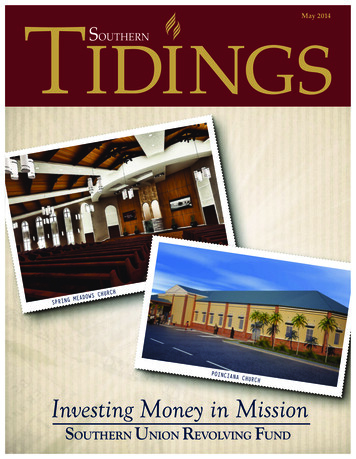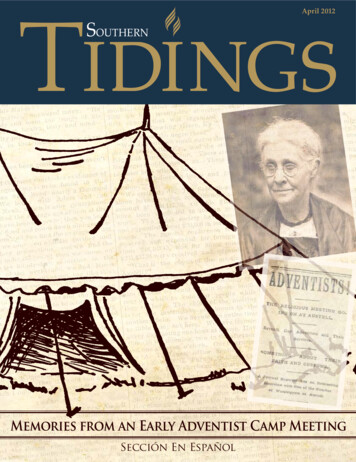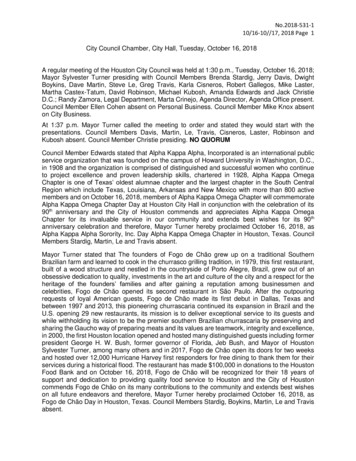
Transcription
ADVENTISTRETIREMENTsummary plan description
Thefuture belongs to those whobelieve in the beauty of their dreams.- Eleanor RooseveltFor additional copies, please contact the Human Resources OfficeAdventist Retirement Plans12501 Old Columbia PikeSilver Spring, MD 20904 6600Editor: Del L. Johnson
table of contents1. Introduction5Type of Plan6This Booklet6Purpose of the Plan6Contributions to the Plan6Plan Administration2. Eligibility73. Contributions8Personal Investment Accounts8Investment Strategy8Employer Basic Contributions8Employee Voluntary Election8Employee Roth Contributions9Employer Match9Rollover Contributions and Transfer Contributions9Contribution Limits10Excess Deferrals10Parsonage Allowance10Vesting of Contributions & Earnings104. Tax Implications11Federal Income Tax11State and Local Income Tax11Social Security - FICA/SECA11Parsonage Allowance Exclusion11
table of contents (continued)5. Payment of Benefits Upon Termination/RetirementIn What Form Will My Benefits Be Paid?12Installments12Lump-Sum Distribution12Annuities13Rollovers to Individual Retirement Accountsand Other Plans13Divorce Situations13Cash-Out of Small Accounts13Which Should I Choose?136. Pre-Termination Withdrawals13Loans From Your Retirement Accounts13Hardship Withdrawals14Disability Distribution14Pre-Retirement Death Distribution14After-Tax Contributions Withdrawals14Pre-Retirement Separation/Termination157. Administration41215Responsibilities15The Plan Is NOT Responsible for15Your Employer’s Responsibility15Your Responsibility16Amendment and Termination16Notice to Participants16
be prepared for theadventures in your lifeINTRODUCTIONThe term “Plan” throughout this document refers to the post-freeze plan called Adventist Retirement Plan,which started on January 1, 2000. The previous plan, called the Defined Benefit Plan, was frozen onDecember 31, 1999.In 1911, the Seventh-day Adventist Church initiated what became a defined benefit retirement plandesigned to provide a reliable flow of funds for career employees who were no longer able to work due toage or illness. The retirement plan has gone through many modifications since then and, as of December31, 1999, the United States defined benefit plan is a frozen plan. (Canada and Bermuda have their ownplans.) This means that as of that date, with few exceptions, no employees of United States employers areearning service credit under the defined benefit plan.In its place, the Church has initiated a defined contribution plan (the “Plan”) for ministers, missionaries andother employees of any United States employer that is eligible to participate, as described below. This Planallows both you and your employer to set funds aside for your retirement.Generally, these funds will be “pretax” to you- that means that you will be able to defer payments on thecontributed funds until you withdraw them from the Plan. This Plan places significant responsibility on you,the employee. You will direct the investment strategies of your retirement funds. You will make contributiondecisions. And, upon retirement, you will make distribution decisions.The Plan allows you to take a distribution of your retirement funds upon termination from denominationalemployment. However, there are limits and tax consequences for Plan distributions depending on how youaccess these funds. (These limits and tax consequences are described in the “Payment of Benefits” sectionof this booklet.) When you are eligible for a distribution, you can choose to leave your funds in the Plan orroll your account balance over to similar investments, allowing the taxes on the funds to continue to bedeferred until the funds are actually paid to you. You can also roll your account balance over to on individualretirement annuity if you want to receive an annuity form of benefit.5
T YPE OF PLANThe Plan is a Church retirement income account program described in Section 403(b)(9) of the Internal Revenue Code (IRC).THIS BOOKLETThis booklet is called a Summary Plan Description. It provides a general description of the Plan and its provisions. As asummary, it cannot be considered an exhaustive description of the Plan and how it would work under all situations. There is alegal Plan document, the Adventist Retirement Plan (ARP), and your rights and obligations, and the rights and obligations ofthe Plan and your Employer are controlled by that document. If this summary is inconsistent with the ARP, the terms of theARP will control.If you wish to review the Plan document, you can do so by contacting the Adventist Retirement Plan’s office or downloadingthe document from the Plan’s website at www.adventistretirement.org.PURPOSE OF THE PLANThe purpose of the Plan is to provide retirement income for the employees of participating employers and their beneficiaries.The contributions that you and your employer make to the Plan, and the earnings on those contributions, are designed toprovide a significant portion of financial security in your retirement. However, few retirement plans are alone adequate tomaintain a pre-retirement standard of living in retirement. Social Security and other personal assets will usually play asignificant role in meeting your retirement income goals.CONTRIBUTIONS TO THE PLANThe Plan is a defined contribution plan. As an employee, you are urged to make voluntary contributions to the Plan. If you areeligible, your employer will match your personal contributions up to a maximum of three percent. In addition, you may also beeligible to receive employer basic contributions. (Eligibility for employer basic and matching contributions is described in the“Eilgibility” section of this booklet.) All contributions (both your voluntary contributions and any employer contributions) willbe credited to your personal account in the Plan after each payday.The Internal Revenue Service (IRS) limits the amount of contributions that both you and your employer con make to the Plan.Complying with contribution limits is your responsibility.PLAN ADMINISTRATIONThe North American Division Adventist Retirement Plan office administers the Plan. If, after reading this booklet, you havequestions regarding the Plan, you should contact:Adventist Retirement Plans12501 Old Columbia PikeSilver Spring,MD gIf you have questions about your Plan investments, you should contact the investment administrator,Empower Retirement, at 1-866-467-7756.6
ELIGIBILITYU.S. Adventist hospitals and related entities, Bermuda, Canada and regional conferences have separate retirement plans. Theiremployees are not eligible to participate in this Plan. Generally, if you are on employee of a U.S. Seventh-day AdventistChurch entity as listed in the SDA Yearbook, or if you are on interdivision missionary from the United States sent by theGeneral Conference of Seventh-day Adventists, you are eligible to make voluntary contributions to the Plan. Since U.S.Adventist hospitals and related entities have a separate retirement plan, their employees are not eligible to participate in thisPlan. In addition, student employees working for Adventist educational institutions are not eligible to participate in the Plan.You may also be eligible to receive employer contributions in this Plan. Although all employees, except for certain studentemployees, are eligible to make voluntary contributions to the Plan, there are different eligibility requirements for employercontributions. Depending on which of two retirement benefit options your employer has selected, your eligibility for employercontributions will be either: Option A1: All employees working on at least a half-time basis are eligible to receive both employer basic and matchingcontributions. Employees working less than half-time are not eligible for any employer contributions. Option A2: All employees working full-time are eligible for employer basic contributions. All employees, including those workingless than full-time, are eligible for employer matching contributions.The only exception to the two eligibility options is for Early Childhood Education Center (ECEC) employees. For ECECemployees, depending on one of two retirement benefit options your employer has elected, your eligibility for employercontributions will be either: Option B1: ECEC employees are eligible for the same retirement benefits as the employer elected for all other employees(either OptionA1 or Option A2 above). Option B2: ECEC employees are not eligible for any employer contributions, regardless of the employer election of benefitsfor other employees.Please contact your local employer’s HR office if you have any questions about which option may apply to you.In addition, the following individuals are eligible to participate in the Plan under certain circumstances: Military service that interrupts the career: If you take leave to serve in the United States armed forces and return to work for yourdenominational employer, you will be eligible for special “make-up contributions.” These are the employer contributions that wouldhave been mode to your Plan account had you not left for employment for military service. These special contributions are notsubject to the various contribution limits discussed elsewhere in this booklet. Chaplains: Adventist chaplains, properly credentialed by the Church, can participate in the Plan by making personal tax-deferredcontributions to the Plan – even though employed by another organization. Also, a chaplain’s employer can make contributions tothe Plan at its option. Graduate study: If you take a leave of absence for graduate study you may be eligible to receive additional employer basiccontributions. In order to be eligible for these additional contributions you must successfully complete a course of graduate studywith a degree at the Master of Arts level or higher, and you must return to full-time employment with your denominational employerwithin one year of completing your study. If you meet these requirements, your employer may make additional basic contributions toyour account. You can receive additional basic contributions for up to two years of graduate study. These contributions will be madeto the Plan over a period of up to four years provided you to work for your denominational employer throughout that period. Disability: If you become disabled prior to termination of employment and are eligible for disability pay under your employer’s longterm disability insurance plan or under Social Security, your employer will continue to make basic employer contributions based onpre-disability pay rates for a period of up to 18 months of disability, including the elimination period.If you are eligible to participate in the Plan, you can enroll by obtaining an application packet from your employer’s Human Resourcesoffice and completing the application according to Plan instructions.7
CONTRIBUTIONSThe Adventist Retirement Plan is a valuable benefit that can help you prepare for and live a secure retirement.PERSONAL INVESTMENT ACCOUNTSUpon enrollment, personal investment accounts will be set up in your name. After each payroll, contributions will be posted toyour account. Earnings on your contributions will be credited on a periodic basis. The funds will be invested according to yourelected investment strategy, which you can change at any time.After the close of each quarter, you will receive a statement of your account balances that reflect all employer contributions,your contributions and earnings on those contributions since the last statement. It is important that you review the statementand make certain that all contributions have been posted to your account on a timely basis, and that your retirement funds arebeing invested according to your instructions.In addition to the quarterly statement, you can contact the Plan’s recordkeeper, Empower Retirement at 1-866-467-7756 or attheir website, www.empower-retirement.com/participant, to determine the current market value of your account.INVESTMENT STRATEGYAs a Plan participant, you have the opportunity to develop your own investment strategy for your retirement funds.The Plan offers a number of investment opportunities, each of which has a specific investment objective. The Plan willprovide information on each of these opportunities, including the objective, historical return on investment and historical“volatility” (that is, how much the earnings rate on the investment option has varied over time). This information is availableat www.empower-retirement.com/participant.If you do not want to select your own investment strategy, the Plan has set up Target Maturity Model investment optionswhich have been designated as the default investment options. Additional information on the Target Maturity Models can befound on the Empower Retirement website at www.empower-retirement.com/participant or by calling Empower Retirement at1-866-467-7756.EMPLOYER BASIC CONTRIBUTIONSIf you meet your employer’s eligibility requirements for employer contributions, your employer will make a basic contributionto your defined contribution account after each payroll. The employer basic contribution rate will be set from time to timeby the North American Division Committee. See the “Eligibility” section of the booklet for information on employereligibility requirements.If you are a commissioned salesperson who is a documented employee of a participating employer, your employer willcontribute based on your commissions. Salespersons who are deemed by relationship documentation to be independentdistributors are ineligible to participate.EMPLOYEE VOLUNTARY ELECTIONYou can make pretax contributions to this Plan based on a dollar amount or a percentage of your salary. Your voluntarycontributions are made pursuant to a salary reduction agreement. Since you do not have access to this part of your salary, youare not generally liable for federal income tax on it until such time as you withdraw it from the Plan.In addition to pretax contributions, you can make voluntary after-tax contributions to the Plan. These after-tax contributions donot reduce your current taxable compensation. (Note: These “after-tax” contributions are different from Roth contributions,which are described later in this booklet, in that they do not need to be made pursuant to a salary reduction agreement. Also,unlike with Roth contributions, the earnings on after-tax contributions are taxable at the time of distribution.)The Plan does not set a maximum on your voluntary contributions, but the IRC limits how much you can contribute. See“Contribution Limits” for a description of these limits.8
EMPLOYEE ROTH CONTRIBUTIONSIf your employer allows, you may choose to make a special type of salary reduction contribution to the Plan called “Rothcontributions.” Roth contributions are similar to voluntary pretax contributions in that they are deducted from your salarybased on your individual salary reduction agreement. Roth contributions are subject to the some contribution limits thatapply to voluntary pretax contributions. (For more information on the applicable limits, see the “Contribution Limits” sectionin this booklet.)Unlike other salary reduction contributions, Roth contributions are made with after-tax dollars. That means that Rothcontributions do not reduce your currently taxable income, but you are not taxed on these contributions when you withdrawthem from the Plan. In addition, if your Roth contributions are distributed in what is called a “qualified distribution,” you willnot be taxed on the earnings on your Roth contributions. A “qualified distribution” is a distribution that: (1) is mode at leastfive years after you make your first Roth contribution to the Plan; and (2) is made after you reach age 59 ½, die or becomedisabled. You should discuss with a tax advisor regarding the benefits of pretax and Roth after-tax contributions.EMPLOYER MATCHAs an incentive to encourage you to make voluntary salary reduction contributions to the Plan, your employer may contributea “match” to your account if you make a voluntary contribution. If you are eligible, your employer will match 100% of yourvoluntary salary reduction contributions up to 3% of your salary. Whether you are eligible for these contributions depends onthe retirement benefit option your employer has selected. See the “Eligibility” section of this booklet for information on thedifferent retirement benefit options. You can contribute more than the amount your employer will match, but you should makesure that you do not exceed IRC limits on total tax-deferred contributions. (See the “Contribution limits” section of thisbooklet.) You should contact Empower Retirement, a tax advisor or your local employer’s HR professional for additionalinformation on the contribution limits.EXAMPLE:EMPLOYER BASECONTRIBUTIONEMPLOYEE PRETAXCONTRIBUTIONEMPLOYER MATCHINGCONTRIBUTIONTOTAL OLLOVER CONTRIBUTIONS AND TRANSFER CONTRIBUTIONSIf you have contributed to another retirement plan, you may also be able to make a rollover contribution or a transfercontribution to this Plan. A rollover contribution is a direct rollover of a distribution made from an IRA or from anotherretirement plan into your account in this Plan. If you are eligible to receive a distribution from another 403(b) plan or from aqualified 401(a) plan, a 403(a) annuity plan, a governmental 457(b) plan or an IRA, you can have that amount rolled overdirectly into this Plan.A transfer contribution can also be made to this Plan. A transfer contribution is different than a rollover contribution in that itmust be made from another 403(b) plan, and it is available only if the other 403(b) plan permits such a transfer.There are a number of legal restrictions on rollovers and transfers. Therefore, if you are a participant in another retirementplan, you should check with the administrator or provider for that plan, as well as with Empower Retirement, to determinewhether you can make a rollover or transfer contribution to this Plan.Rollover contributions and matching contributions are not eligible for employer matching contributions.9
CONTRIBUTION LIMITSThe Internal Revenue Code limits the amount that you and your employer can contribute to your account. Some of the limitscalculations require information from previous tax deferrals. These calculations will only be as reliable as the information youprovide. You are ultimately responsible for ensuring that you do not exceed the IRC limits. You can contact EmpowerRetirement, a tax advisor or your local employer’s HR professional for additional information on IRS contribution limits.Essentially, tax laws set two limits, and you must meet the requirements of each of these limits.The first is a flat dollar limit on voluntary contributions.·Limit on elective deferrals: Voluntary contributions mode under a salary reduction agreement (including any Rothcontributions) cannot exceed 18,000 in calendar year 2015. However, if you are age 50 or older, your availablelimit could be increased.The second limit applies to all contributions made to the Plan, both employer and employee contributions (but not includingany rollover or transfer contributions). As a general rule, the total contributions by you and your employer cannot exceed thelesser of a specific dollar limit ( 53,000 in 2015) or 100% of your “includible compensation.” For purposes of this rule,“includible compensation” is your taxable compensation plus any salary reduction contributions you make to this Plan andcertain other salary reduction contributions mode to other plans (including any cafeteria plan your employer may offer). If youare a minister, “includible compensation” does not include any compensation designated as parsonage or housing allowance.· If your includible compensation is less than 10,000, or if you are a foreign missionary with little or no taxable income,there are special exceptions under this rule. You might wish to contact a tax advisor or your local employer’s HRprofessional for additional information on these options.EXCESS DEFERRALSIf it is determined that you have exceeded the limit on elective deferrals, the Plan provides that the excess amount (includingearnings on that excess amount) will be refunded to you by April 15 of the year following the year in which the excesscontribution was mode to the Plan. The excess contribution will be treated as taxable income to you in the year of the deferraland any earnings on the excess contribution will be taxable in the year of the refund.PARSONAGE ALLOWANCEIf you are a minister with a significant parsonage allowance exclusion, you will have a correspondingly smaller taxablecompensation base upon which to calculate the contribution limits. These limits may reduce the amount that you cancontribute to the Plan. You should consult with a tax advisor or your local employer’s HR professional if you anticipate thatyour parsonage allowance exclusion will not leave enough taxable compensation to meet your retirement contribution goals.VESTING OF CONTRIBUTIONS AND EARNINGSAll employee voluntary contributions and earnings on those contributions are nonforfeitable. In addition, as of July 1, 2011,employer basic and match contributions are nonforfeitable, including balances in existing basic and match contributionaccounts. In other words, beginning July 1, 2011, you are 100% vested on your entire account in the Plan.MODEST ALLOWANCEGross IncomePARSONAGE 40,000Parsonage Allowance 20,000Taxable Compensation 20,000General Rulex100%Maximum Deferrals 20,000Actual Deferrals10· Empoyee Basic 2,000· Empoyee Voluntary 1,200· Empoyee Match 1,200Total Deferrals 4,400Additional Deferral Available 15,600
SIGNIFICANT ALLOWANCEPARSONAGEGross Income 40,000Parsonage Allowance 37,000Taxable Compensation 3,000General Rulex100%Maximum Deferrals 3,000Actual Deferrals· Empoyee Basic 2,000· Empoyee Voluntary 1,200· Empoyee Match 1,200Total Deferrals 4,400Additional Deferral Available -1,400TAX IMPLICATIONSIn this section, certain tax matters are discussed in a general way. You should consult your tax advisor if youhave technical questions.FEDERAL INCOME TAXNeither employer contributions nor your pretax contributions are subject to federal income tax in the year contributed. YourW-2 will show a reduced taxable income for federal tax purposes. Withdrawals will create a potential tax liability. In most casesthis will be after retirement, and could be at a lower tax rate.STATE AND LOCAL INCOME TAXMany states and some localities have their own income tax. Generally, this tax is calculated on the some taxable income shownon the W-2 to calculate federal income tax. However, some states and localities have other rules. If you are subject to suchtaxes, you should consult with a tax advisor or the tax office of the state or locality in question.SOCIAL SECURIT Y – FICA /SECAEmployer contributions are not subject to Social Security or Medicare payroll taxes. In addition, a minister’s voluntary pretaxcontributions are not subject to Social Security or Medicare taxes – that means that a minister does not have to pay SECAtaxes on these contributions. However, salary reduction contributions made by employees who are not ministers are subject toSocial Security and Medicare taxes.PARSONAGE ALLOWANCE EXCLUSIONIf contributions to the Plan were made at the time you were performing services in the exercise of your ministry, uponretirement, distributions from the Plan may be eligible to be treated as a parsonage allowance. Each year, the ARP Boardmakes a designation so that 100% of a distribution that is attributable to contributions earned while you were performingservice in the exercise of ministry is eligible for the parsonage allowance. That means that upon retirement, up to 100% ofyour annual taxable distribution from the Plan can be considered to be parsonage allowance and may be excluded from yourtaxable income. The amount actually excludable as parsonage allowance cannot exceed the least of the following:···The fair rental value of your furnished home, plus the cost of utilitiesThe actual expenses of operating your homeThe portion of your Plan distribution that is attributable to contributions earned while you were performing servicein the exercise of ministryIt is important to note that only distributions paid directly from the Plan are eligible for this tax benefit. If you roll the fundsover to an individual retirement annuity, IRA or some other retirement plan, you may not be able to use the ParsonageAllowance on distributions from those plans.Upon your retirement, the Plan can assist you, if requested, in setting up Plan distributions so that you can maximize thebenefit of a designated parsonage allowance within the context of tax laws. You might wish to consult your tax consultanton how to best make use of your parsonage allowance exclusion.11
PAYMENT OF BENEFITSThis section describes benefit payments upon termination or retirement.If you terminate denominational employment, you are permitted to take a distribution of all your voluntary contributionsand any rollover and transfer contributions you may have made to the Plan. You are also permitted to take a distribution ofemployer contributions (both basic contributions and matching contributions). However, if you are under 59 ½, your employercontributions accounts must be rolled over directly to another retirement plan or to an IRA. Funds withdrawn from the Planwill normally be taxable and, if withdrawn prior to age 59 ½, may be subject to a 10% federal early withdrawal penalty. Youcan avoid the taxes (including the 10% penalty) if you roll your Plan distribution over to on IRA or other eligible retirementplan. See the “Rollovers to Individual Retirement Accounts (IRAs) and Other Plans” section of this booklet for moreinformation on rollovers.When you retire, or are otherwise eligible to receive a distribution from your account balance, you must request andcomplete the appropriate distribution paperwork. Empower Retirement can provide this paperwork, and will process thedistribution after you have signed and returned the paperwork. You can contact Empower Retirement at 1-866-467-7756for more information.You will need to make important decisions regarding the method for distributing your account balance. The Plan will holdregional pre-retirement planning workshops from time to time, and you should plan to attend. You might also wish to consulto family financial planner for advice on how best to meet your retirement needs. The retirement distribution will, in all cases,be limited to the funds in your account balance. The Plan maintains no separate “welfare fund” for special needs and is notable to make discretionary donations for special needs.IN WHAT FORM WILL MY BENEFITS BE PAID?Two basic forms of payments are available under the Plan and are described below. In addition, if you want on annuity form ofbenefit, you can roll your account balance over to on “individual retirement annuity.” You must choose the form of paymentbefore any distribution is made to you. If you are married, your spouse must consent to the benefit option selected.INSTALLMENTSThis form of benefit provides you with installment payments for a designated number of years which you specify. However,federal regulations provide that you may not have payments made over a period that is longer than your life expectancy or thejoint life expectancy of you and your designated beneficiary. These regulations also require that payments must begin underthis form of benefit no later than the calendar year in which you retire from, or the calendar year in which you attain age 70 ½,whichever occurs later.If you elect to receive installment payments, any amount remaining in your account after you die will be paid to yourdesignated beneficiary.LUMP-SUM DISTRIBUTIONYou can receive all or part of your retirement accumulation in the form of a lump-sum. This could, of course, create a significanttax liability and the Plan is required to withhold 20% if you request a lump-sum payout that is not directly rolled over to an IRAor to another qualified retirement plan. In addition, if you are eligible for parsonage allowance, you need to remember thatthe amount of parsonage allowance that you are eligible to claim cannot exceed the lesser of your housing expenses duringthe year of the distribution or the fair rental value of your home (plus utilities) in the year of the distribution.12
ANNUITIESAn annuity is a flow of funds that provides a monthly benefit to you during your life. If you want to receive your benefits in theform of on annuity, you can elect a lump-sum distribution and roll your distribution over to on individual retirement annuityprovided through on insurance company of your choice. The amount of the monthly payment you receive depends on a varietyof factors: how old you are at the time that payments begin, how much you roll over to purchase the annuity; expectedinvestment returns; whether you wish to have your annuity protected against inflation; and whether you wish to have benefitspaid to your spouse if you pass away before your spouse does.If you roll your account over to on individual retirement annuity, you will not be taxed at the time of the rollover from the Plan.Instead, annuity payments are normally taxable in the year received.ROLLOVERS TO INDIVIDUAL RETIREMENT ACCOUNTS AND OTHER PLANSIn addition to rolling your Plan distribution over to purchase on individual retirement annuity, you can also roll all or a portion ofyour account over into on individual retirement account (IRA). You can set up on IRA with Empower Retirement, banks, brokersor other financial institutions. You can invest the rolled over amounts according to your wishes and, subject to your agreementwith the IRA provider, you can withd
The Adventist Retirement Plan is a valuable benefit that can help you prepare for and live a secure retirement. PERSONAL INVESTMENT ACCOUNTS Upon enrollment, personal investment accounts will be set up in your name. After each payroll, contributions will be posted to your account. Earnings on your contributions will be credited on a periodic basis.










